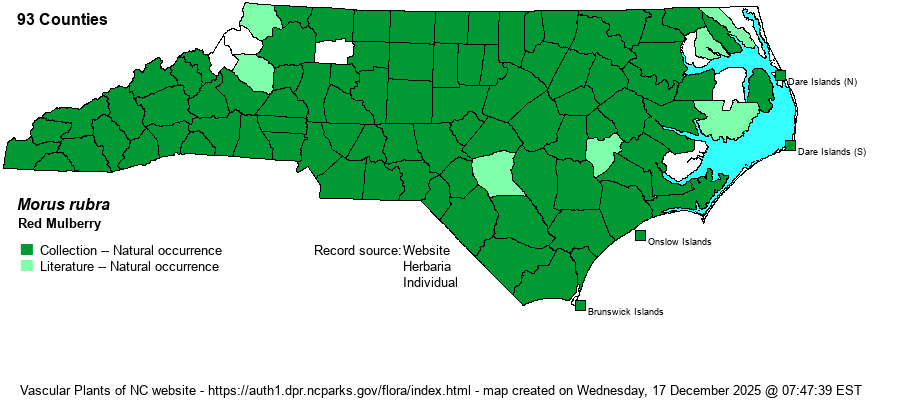| Author | L. | |
| Distribution | Throughout the state, though possibly absent from a few northern Mountain counties. Scarce to possibly absent in a few counties north of Albemarle Sound, though the counties in VA along the state line all have records in that part of the state. Likely occurs in all 100 counties.
This Eastern species has been documented from nearly every county within its large range. Ranges north to VT and MN, south to the Gulf of Mexico from FL to TX.
| |
| Abundance | Common over nearly all of the state, but scarce in far eastern counties and in higher Mountains. | |
| Habitat | It is widespread in rich to somewhat mesic soils, especially in bottomlands and mesic forests. It also can colonize recently disturbed areas, at least in wooded openings. It is certainly not a species limited to high-quality forest stands, but it can occur in woodlots and other semi-forested sites. |
| Phenology | Flowers in April and May, and fruits in May and June. | |
| Identification | This well-known species can be seen on many or most days afield by biologists, at least in hardwood or mixed forests. It is a small to medium deciduous tree, averaging about 50-60 feet tall. The alternate leaves are distinctive from all but a few other tree species, in that they are almost rounded, with a slightly cordate base and an acuminate tip, thus being a bit heart-shaped. The margins are clearly serrated, and the leaves are bright to dark green above and quite heavily veined. Occasional leaves have one or two thumb-like lobes, making them quite distinctive. In fact, some leaves can have several finger-like lobes. American Basswood (Tilia americana), which has several varieties in the state, has very similar broadly cordate leaves, but they are never lobed, and the leaf buds are reddish and rounded with few scales. Mulberry has more typical terminal brown buds with a handful of tightly overlapping scales. Several non-native mulberry species -– such as White Mulberry (M. alba) and Paper Mulberry (Broussonetia papyrifera) -– are fairly widespread in the state, but they are always found in highly disturbed sites; the first has smooth leaves below and mainly above (Red Mulberry leaves are pubescent below and scabrous above), and the second has strongly tomentose stems and leaves and some leaves are opposite on the branches. As all know, by early summer mulberries show the very distinctive dangling cylindrical fruit composed of multiple berries, first red and then turning deep purple to black. | |
| Taxonomic Comments | A few references list varieties but most do not. Because of its wide range, there is certainly some variability in plants from one part of the range to another.
| |
| Other Common Name(s) | Common Mulberry. Often simply called “Mulberry”, and it is indeed the only native Morus species in North America; however, with several other non-natives in the state with “Mulberry” in the name, it is strongly preferable to use a modifier name for any such species. | |
| State Rank | S5 | |
| Global Rank | G5 | |
| State Status | | |
| US Status | | |
| USACE-agcp | FACU link |
| USACE-emp | FACU link |

